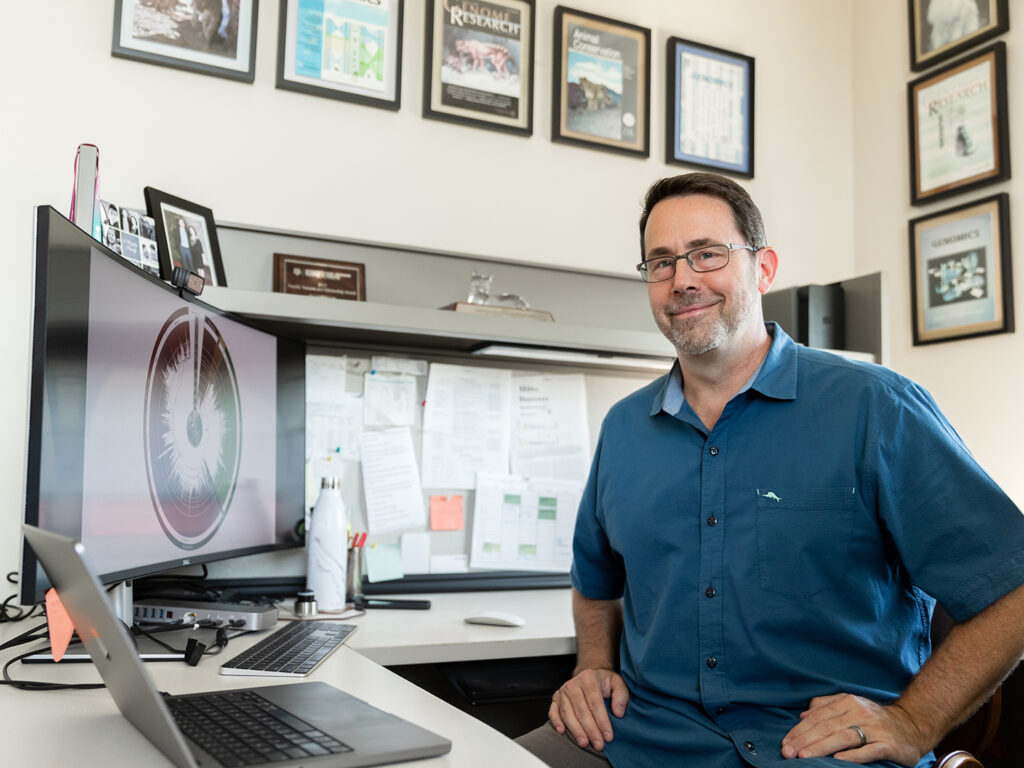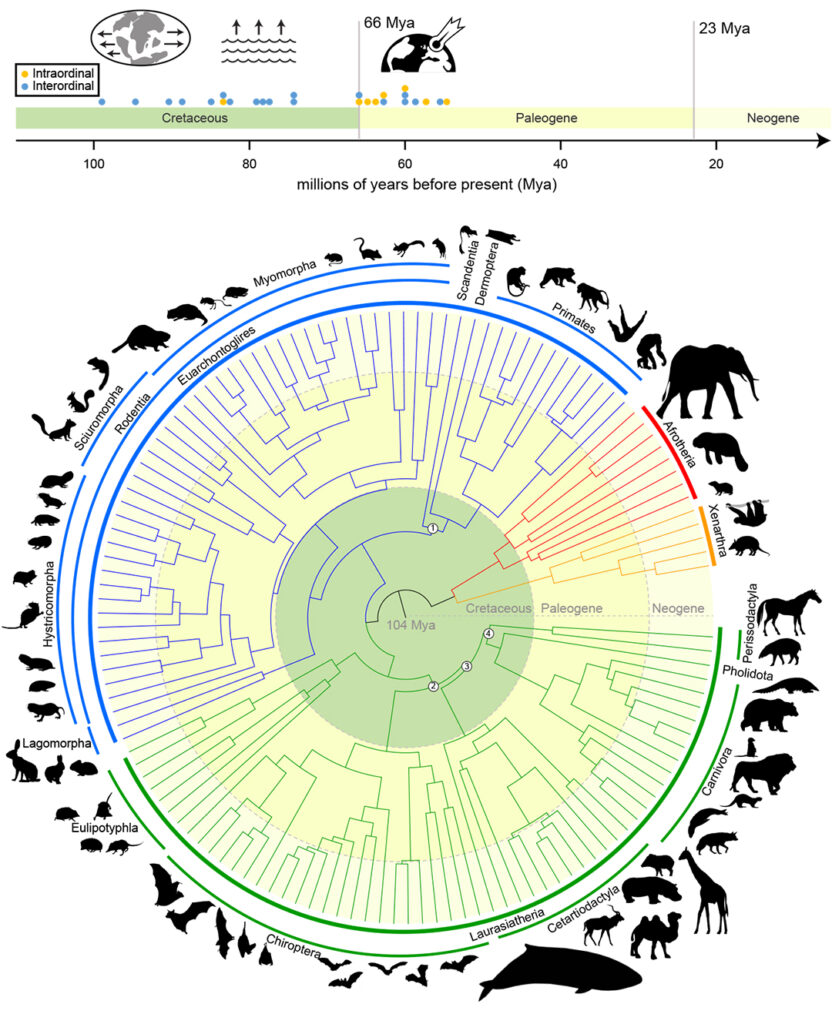VMBS Researcher Elected To National Academy Of Sciences
Story by Courtney Price, VMBS Communications
Dr. William Murphy’s groundbreaking research on mammalian evolution and cat genomics earns one of science’s highest honors.

Photo by Jason Nitsch ’14, School of Veterinary Medicine & Biomedical Sciences
A professor in the Texas A&M School of Veterinary Medicine & Biomedical Sciences (VMBS) has been elected to the National Academy of Sciences (NAS).
Dr. William Murphy — the James E. Womack University Professor of Genetics in the Department of Veterinary Integrative Biosciences (VIBS) — is one of 144 new members and the only faculty member from Texas A&M elected during this cycle.
The NAS is a private, nonprofit institution established under a congressional charter by President Abraham Lincoln in 1863. It is one of three national academies that provide science, engineering and health policy advice to the federal government and other organizations, including the International Science Council.
Elected members are recognized for their achievement in science.
Murphy has received this honor — one of the highest that a scientist can achieve — for his research using comparative genomics to describe and understand evolutionary processes in mammals that result in different species, adaptations and overall biological diversity. His work has helped redefine the mammalian tree of life and transform scientists’ understanding of biology, especially through his research on the domestic cat genome.
His work has even been featured on the covers of highly regarded publications like Science, Nature, Genome Research, the Journal of Heredity, and Genomics.
“Dr. Murphy is one of the most influential scholars in his field worldwide. His seminal scientific achievements have had transformational impacts on the biology of mammals and the health and conservation of cats,” said Dr. John R. August, the Carl B. King Dean of Veterinary Medicine. “We are so proud that Dr. Murphy has received this highest honor for the breakthrough research discoveries that he has made as a faculty member of over 20 years at Texas A&M University. We are also thankful for his service as our assistant dean for the VMBS’ Office of Research and Graduate Studies.”
Redefining The Tree Of Life

Some of Murphy’s most transformative work has come from his participation in the Zoonomia Project, an international consortium of scientists who use the largest mammalian genomic dataset in history to answer questions about human evolution as it relates to overall mammal evolution.
In a study published last year, Murphy and his colleagues were able to provide a definitive answer regarding the evolutionary timeline of mammals over the last 100 million years. They found that mammals were already experiencing species diversification even before the mass extinction that wiped out non-avian dinosaurs.
According to the study, mammals saw even more diversification after the extinction because they no longer had to compete with as many dinosaurs for room, resources and stability. This accelerated rate of diversification is why there are so many different mammal lineages, including carnivores, primates and hoofed animals.
The ability of scientists to compare the human genome with so many mammal genomes using the Zoonomia Project’s data has led to important discoveries impacting health and medical treatments for both animals and human beings.
Unveiling The Secrets Of Cat DNA
Murphy is also regarded as an expert in cat evolution and genomics, with his work providing the foundation for medical treatment development and conservation efforts that promote feline health and well-being. Some of his recent research has helped scientists better understand what makes different cat species unique, including how they have adapted to their environments.
For example, Murphy’s research into cat olfactory genes — the parts of cat DNA that govern their ability to smell — has revealed important differences between lions and tigers. Tigers, as it turns out, have a larger repertoire of genes that enhance their ability to smell and detect pheromones.
This is likely because tigers are solitary animals that need to be able to detect prey and potential mates across large territories, while lions typically live in much closer proximity to other lions.
While discoveries like this one help scientists better understand species behaviors, they also contribute directly to conservation efforts. For example, understanding how different populations of tigers have evolved to live in different environments — from hot, humid jungles to snowy tundras — helps make it clear to policymakers that these populations are not interchangeable.
A Distinguished Career
Murphy received his Ph.D. in biological sciences in 1997 from The University of Tulsa before becoming a postdoctoral researcher — and then senior scientist — at the Laboratory of Genomic Diversity at the National Institutes of Health’s National Cancer Institute.
After joining Texas A&M in 2004, Murphy was named a Presidential Impact Fellow in 2017 and a University Professor in 2020. Over the course of his career, he has published more than 130 articles in peer-reviewed journals and currently serves as the editor in chief of the Journal of Heredity.
Only 14 other living faculty members at Texas A&M are NAS members; the only other member from the VMBS is Dr. Leif Andersson, also a VIBS professor.
“We are very proud of Dr. Murphy and are excited to see how he continues to change the field of comparative genomics,” said Dr. Michael Criscitiello, a professor in the VMBS’ Department of Veterinary Pathobiology and the associate dean for the VMBS’ Office of Research & Graduate Studies. “It’s very fitting that he has been given this honor, since he is the James E. Womack University Professor of genetics, and the late Dr. Womack was also a member of the NAS.”
“Bill’s work has provided fundamental advancements in phylogenetics and genomics,” said Dr. Alex C. Keene, professor and head of the Texas A&M Department of Biology, where Murphy holds a courtesy joint appointment. “He has elevated the stature of research at Texas A&M and, more broadly, as the chief editor of the Journal of Heredity for the last seven years. He has always taken the time to support junior faculty and students across the campus in a way that has advanced the careers of dozens of younger scientists. This is really so exciting for Texas A&M, and we are all so happy for Bill!”
###
For more information about the Texas A&M College of Veterinary Medicine & Biomedical Sciences, please visit our website at vetmed.tamu.edu or join us on Facebook, Instagram, and Twitter.
Contact Information: Jennifer Gauntt, Director of VMBS Communications, Texas A&M College of Veterinary Medicine & Biomedical Sciences, jgauntt@cvm.tamu.edu, 979-862-4216


